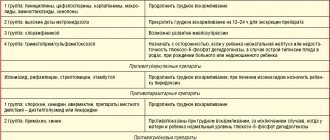Most mothers can produce quite a lot of milk for their babies. But some mothers may worry that the baby does not have enough milk. In order to make sure whether the child really does not have enough milk, you can check the weight according to the child’s age according to the World Health Organization charts.
Weight-for-age chart for girls from birth to five years
Weight-for-age chart for boys from birth to age five
There may be situations when a mother thinks that she does not have enough milk, but in reality everything is fine:
- During the period when the baby's age ranges from 6 weeks to 2 months, the mother may feel that her breasts are no longer full. Don't be afraid of this - it's normal. Some women never experience the feeling of full, full breasts. This does not mean that less milk is being produced than required - simply that the mother’s body is adapting to the individual needs of her child. The baby may nurse for only 5 minutes, or it may take 10-15 minutes or more. A child can eat from one breast or from two at a time - each child is different.
- Growth spurts can make your baby want to eat longer and more often. These growth spurts can occur at 2 to 3 weeks of age, 6 weeks, and 3 months of age. A growth spurt can occur at any other time. Monitoring the ratio of body weight and height will verify the presence of such a jump. Don't worry about not having enough milk supply: just practice feeding according to your baby's needs, following his rhythm. The child himself will show how often and for how long he wants to eat. Feeding more frequently will help increase your milk supply.
What can you do to get enough milk?
- Check that the baby is correctly attached to the breast and that his sucking is reliable and effective.
- Breastfeed often - according to the baby's needs. The child must determine his own feeding schedule and duration of sucking. If the baby does not empty the breast completely, it is necessary to express milk. The more often your breasts empty, the more milk they will produce.
- Offer both breasts at each feeding. Let your baby use the first breast as long as he sucks and swallows at a normal rhythm. As soon as he slows down or stops, offer him the other breast.
- Try not to give baby formula or cereal in addition to breast milk. Otherwise, the baby may lose interest in breast milk and the milk supply will decrease. If you need to supplement your baby's nutrition, try using a spoon, a syringe without a needle, a cup or tube of breast milk, a breastfeeding system, or a silicone pipette.
- Do not use nipple bottles or pacifiers. Their use will lead to the formation of an incorrect sucking stereotype in the child, and when breastfeeding, he will suck the nipple instead of the breast. This will reduce your milk intake and may cause nipple and breast problems.
- Use the breast compression method, your lactation consultant can teach you how to use it correctly.
If the above steps do not help, consult a lactation specialist or doctor.
Folk remedies
The best option in such a situation would be to consult a doctor in a timely manner, but if this is not possible, and the breasts continue to burst from gushing milk, it is worth trying some folk remedies, including:
- breast massage;
- compresses made from camphor oil and chopped parsley;
- ice packs applied to the chest;
- bandaging the chest with an elastic bandage;
- infusions and tea from herbs such as sage, hop cones, mint, bearberry, alder, lingonberry, horsetail, elecampane.
All these remedies are available to every woman, so her health is only in her hands. And yet, you should not try to eliminate this problem on your own: no one except a doctor can help with hyperlactation. Having coped with the panic, received advice from a specialist and waited a couple of days, you need to be happy that the baby is not in danger of running out of invaluable breast milk.
What can be done:
- Feed your baby from only one breast at each feeding.
- If your other breast feels full before your next feeding, you can express a little milk. You can also use a cool, wet compress to reduce discomfort and swelling.
- You can start feeding your baby before he gets hungry to reduce the aggressiveness and assertiveness of his sucking, which can be one of the causes of overproduction of milk. Help your baby periodically release air from his stomach (burp) by stroking and lightly tapping his back while holding him in an upright position.
Some women experience a strong release of milk from the nipples. This may occur simultaneously with the breast being full of milk, or be a consequence of a strong reflex separation of milk in response to the baby's sucking.
About nutrition during hyperlactation
A woman facing the problem of hyperlactation should know which foods increase milk production and immediately exclude them from her diet. These include:
- warm or hot tea with milk, ginger or honey (this applies to both green and black teas);
- dried fruit compotes;
- dried fruits themselves;
- caraway and dill;
- nuts and seeds;
- feta cheese and Adyghe cheese;
- watermelon, onions, green salad, carrots and radishes;
- buckwheat and rolled oats;
- currants and blackthorns;
- infusions, decoctions and teas of oregano, lemon balm, nettle, dandelion, anise and hawthorn.
Of course, all these foods are very healthy and are a treasure trove of vitamins, but for 2-3 days, until the heaviness in the chest subsides, it is better to give them up. To relieve pain, you can use folk remedies.
What can be done:
- Before feeding, pinch the nipple between your thumb and middle finger and squeeze it lightly to compress the milk ducts and reduce milk let-down.
- If your baby is choking while sucking, gently use a clean finger in the corner of his mouth to stop the sucking and express some milk into a tissue or towel.
- Allow your baby to latch on and release the breast during feeding as he or she wishes.
- Feed in a relaxed (biological) feeding position, this will allow gravity to prevent the active flow of milk up into the baby's mouth.
Seek help from a lactation consultant if you are unable to cope with excess milk on your own.
Signs of insufficient lactation
To assess the adequacy of lactation, a thorough analysis of the child’s behavior, frequency of urination, and the nature of stool is necessary. Possible signs of insufficient lactation are:
- the child’s screaming and restlessness during or immediately after feeding;
- the need for frequent breastfeeding;
- long-term feeding, during which the child makes a lot of sucking movements in the absence of swallowing movements;
- the mother feels that the mammary glands are quickly completely emptied when the baby is actively sucking; when pumping after feedings, there is no milk;
- restless sleep, frequent crying, “hungry” cry;
- low rate of baby weight gain;
- infrequent bowel movements and urination*.
Call a breastfeeding specialist to your home
At the Group’s children’s medical centers, we know that the most convenient place for breastfeeding consultations is your own cozy home:
- A specialist will come to you at a convenient time. You don't have to go to the clinic and wait in line. Consultations can also be held directly in the maternity hospital (if visits are permissible) or in a medical center.
- A familiar home environment makes consultation easier for both mother and child.
- At home, the consultant will be able to devote more time to both the child and the parents.
- The consultant is always a phone call away: day and night (at night you can call the contact center or write to the consultant, the consultant will answer as soon as possible), on weekdays and on weekends.
- Support from a specialist is not one-time consultations, but accompaniment: the consultant will visit the mother and baby again, if necessary, after 2-4 weeks to check how feeding is going and the baby’s weight gain.
In addition to calling a breastfeeding specialist to your home, you can call doctors of the main specialties: pediatrician, surgeon, allergist, urologist, pulmonologist, hematologist, dermatologist, ophthalmologist, ENT doctor, orthopedist, gastroenterologist and osteopath. You can also take tests, perform physiotherapy and massage at home. Infant swimming consultants can advise you at home and conduct a master class.
Find out about the special offer “Comprehensive examination at home”: the convenience of this program is that you can choose from a list of pediatric doctors exactly those specialists that your child needs and an individual set of medical services with a 20% discount!
Is it possible to do “incentive pumping” with a single breast pump?
I've seen a lot of questions about whether a single electric breast pump can be used for "incentive pumping."
In general, it is generally recommended to use a double electric breast pump
to
express milk from both breasts at the same time
, and thus reduce the time you have to devote to pumping.
However, "incentive pumping" is possible with a single electric breast pump.
Here's what you can do (I'm only using 10-minute time intervals for clarity, but you can change the duration of the intervals to suit your needs).
- Pump your right breast for 10 minutes (do nothing with your left)
- Switch sides, express your left breast for 10 minutes (the right one rests)
- Switch sides, express the right breast for 10 minutes (the left one rests)
- Switch sides, express your left breast for 10 minutes (the right one rests)
- Switch sides, express the right breast for 10 minutes (the left one rests)
- Switch sides, express your left breast for 10 minutes (the right one rests)
In total you will need 1 hour. That is, you'll still pump for an hour, but instead of resting 10 minutes between "double pumps," you switch sides and continue pumping, then repeat again until you've pumped each breast three times.
Advantages of calling Virilis Group specialists to your home
- Travel to any area of the city and region without restrictions.
- No insurance, registration or citizenship is required to receive medical care.
- Providing assistance to children of any age.
- Experience in responsible treatment of children in St. Petersburg since 1991.
- 6 own children's medical centers with 650 specialists in 49 specialties.
- Possibility of diagnostics and continuation of treatment in our clinics.
- Coordination with other doctors of the VIRILIS Group of Companies clinics: we are a single team, and not individual doctors from a “mobile” clinic.
- 24/7 contact center.
- Issuance of official medical certificates and documents.
- Possibility of purchasing a package of a comprehensive medical program for a child, including the “Emergency Care” and “Comprehensive Examination at Home” packages.
- Special medical programs for newborns and infants.
Examples of the results of “stimulating pumping”
Note: If the specific example does not provide details, it means that the mother is using a one-hour session schedule (20-10-10-10-10).
| From 150 ml to 270 ml per week |
| This mother could only pump 150 ml per pumping. After regular “stimulus pumping” twice a day (early morning and night) for a week, the mother was able to increase the volume of milk she expressed to 270 ml. Please note that after each pumping, mom used the Marmet hand expression technique. The child was over 1 year old. |
| From 90 ml to 240 ml in one session in two weeks |
| This mom did an “incentive pump” once a day (last pump before bed). She used the following pumping schedule: pump 20 minutes - rest 10 minutes - pump 10 minutes - rest 10 minutes - pump 10 minutes. OR pumping 15 min – rest 15 min – pumping 10 min – rest 10 min – pumping 10 min – rest 5 min – pumping 5 min. Result: In two weeks, this mother managed to increase the amount of milk she expressed from 90 ml to 240 ml, and replenish the milk bank in the freezer. |
| From 45 ml to 90 ml in three days |
| Alisha could express 15-45 ml in one pumping session. She did “incentive pumping” in the evening, once a day (for an hour) for 3 days and after that she was able to pump 75-90 ml per pump. |
| From formula supplementation to full breastfeeding! |
| This mother did not have enough milk and the baby needed supplemental feeding with formula. He did “incentive pumping” three nights in a row plus pumped 1 hour after feeding. Result: she was finally able to stop supplementing with formula, yay! |
| From drops to 50 ml per pumping |
| This mother did “incentive pumping” according to the Casemore scheme, pumping for 30 minutes every 2 hours for two days (48 hours). Result: Previously she could only express drops. In just those 48 hours, she was only able to express 75 ml. However, the day after this “marathon” she was able to express 50 ml in just one pumping session. The child was older than 6 months. |
| From 150 ml to 300 ml per pumping. |
| This pumped-only mom was pumping less than 148ml before she tried boost pumping. The supply of expressed milk in the freezer was close to 0. Her “incentive pumping” schedule looked like this: she pumped every two hours for 15 minutes for two days (Saturday and Sunday). Result: The effect was not immediate. On Monday she felt her breasts filling up more. By the end of the week, she had managed to express about 300ml per pumping session, which allowed her to replenish her milk bank at home. The child was older than 9 months. |
| From 90 ml to 210 ml using cluster pumping |
| This mom used cluster pumping for 5-15 minutes every half hour for a 3-4 hour interval. Here's her cluster pumping schedule: From 8.00 to 11.00 am (rest time - 30 minutes):
She had two of these cluster pumping sessions every day for 4 days. Result: Previously she could express about 90 ml, but after cluster pumping she was able to express 210 ml in one pumping session. |
| Restoring a milk bank when there is a shortage of supplies |
This mother arranged cluster feeding and pumping twice a day:
Result: Previously, her milk bank had a deficit of 150 ml daily, but after cluster feeding and pumping, she was able to add 1065 ml to the milk bank in addition to the portions needed every day.. |






